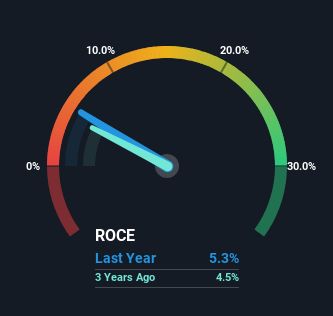- South Korea
- /
- Interactive Media and Services
- /
- KOSE:A035420
NAVER (KRX:035420) Will Be Hoping To Turn Its Returns On Capital Around

Finding a business that has the potential to grow substantially is not easy, but it is possible if we look at a few key financial metrics. One common approach is to try and find a company with returns on capital employed (ROCE) that are increasing, in conjunction with a growing amount of capital employed. This shows us that it's a compounding machine, able to continually reinvest its earnings back into the business and generate higher returns. Although, when we looked at NAVER (KRX:035420), it didn't seem to tick all of these boxes.
What Is Return On Capital Employed (ROCE)?
For those who don't know, ROCE is a measure of a company's yearly pre-tax profit (its return), relative to the capital employed in the business. The formula for this calculation on NAVER is:
Return on Capital Employed = Earnings Before Interest and Tax (EBIT) ÷ (Total Assets - Current Liabilities)
0.053 = ₩1.6t ÷ (₩36t - ₩5.8t) (Based on the trailing twelve months to March 2024).
Therefore, NAVER has an ROCE of 5.3%. In absolute terms, that's a low return and it also under-performs the Interactive Media and Services industry average of 11%.
See our latest analysis for NAVER

In the above chart we have measured NAVER's prior ROCE against its prior performance, but the future is arguably more important. If you're interested, you can view the analysts predictions in our free analyst report for NAVER .
The Trend Of ROCE
On the surface, the trend of ROCE at NAVER doesn't inspire confidence. Over the last five years, returns on capital have decreased to 5.3% from 11% five years ago. Although, given both revenue and the amount of assets employed in the business have increased, it could suggest the company is investing in growth, and the extra capital has led to a short-term reduction in ROCE. And if the increased capital generates additional returns, the business, and thus shareholders, will benefit in the long run.
On a side note, NAVER has done well to pay down its current liabilities to 16% of total assets. So we could link some of this to the decrease in ROCE. What's more, this can reduce some aspects of risk to the business because now the company's suppliers or short-term creditors are funding less of its operations. Some would claim this reduces the business' efficiency at generating ROCE since it is now funding more of the operations with its own money.
In Conclusion...
In summary, despite lower returns in the short term, we're encouraged to see that NAVER is reinvesting for growth and has higher sales as a result. Furthermore the stock has climbed 49% over the last five years, it would appear that investors are upbeat about the future. So while the underlying trends could already be accounted for by investors, we still think this stock is worth looking into further.
If you're still interested in NAVER it's worth checking out our FREE intrinsic value approximation for A035420 to see if it's trading at an attractive price in other respects.
For those who like to invest in solid companies, check out this free list of companies with solid balance sheets and high returns on equity.
Valuation is complex, but we're here to simplify it.
Discover if NAVER might be undervalued or overvalued with our detailed analysis, featuring fair value estimates, potential risks, dividends, insider trades, and its financial condition.
Access Free AnalysisHave feedback on this article? Concerned about the content? Get in touch with us directly. Alternatively, email editorial-team (at) simplywallst.com.
This article by Simply Wall St is general in nature. We provide commentary based on historical data and analyst forecasts only using an unbiased methodology and our articles are not intended to be financial advice. It does not constitute a recommendation to buy or sell any stock, and does not take account of your objectives, or your financial situation. We aim to bring you long-term focused analysis driven by fundamental data. Note that our analysis may not factor in the latest price-sensitive company announcements or qualitative material. Simply Wall St has no position in any stocks mentioned.
Have feedback on this article? Concerned about the content? Get in touch with us directly. Alternatively, email editorial-team@simplywallst.com
About KOSE:A035420
NAVER
Provides online search portal and online information services in South Korea, Japan, and internationally.
Flawless balance sheet and undervalued.
Similar Companies
Market Insights
Community Narratives





